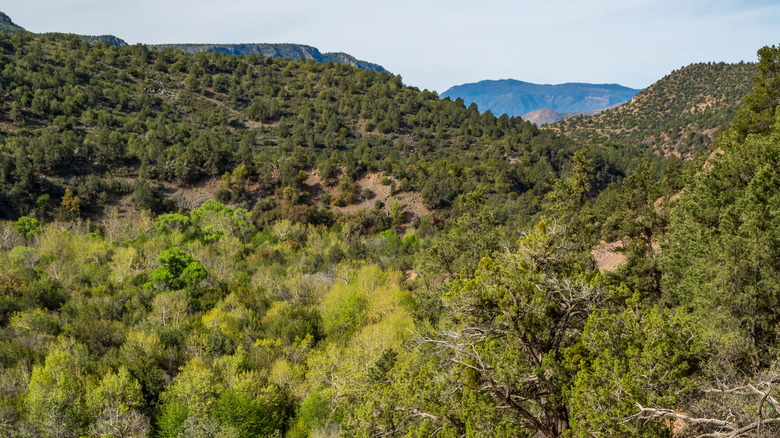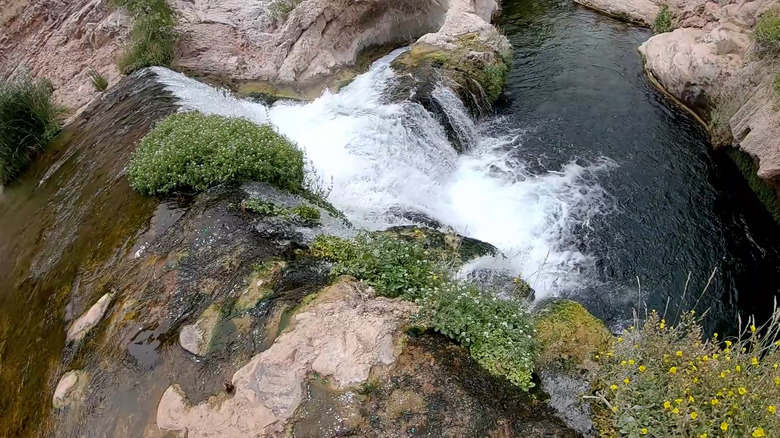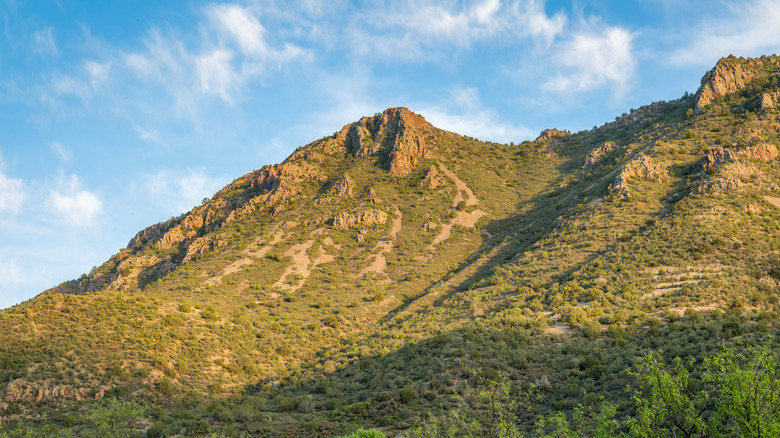Staggering turquoise water, shady grottos, and rushing waterfalls are probably not the first thing that comes to mind when picturing an Arizona hike, but Bob Bear Trail has them all. Found within Arizona’s Coconino National Forest, this hike is tremendously popular for its gorgeous views — but it shouldn’t be taken lightly. Bob Bear Trail, formerly known as “Fossil Creek,” is between 8.4 and 8.75 miles depending on the route you choose, and takes you more than 1,500 feet down and then back up again.
This hike is not the most difficult one in the state, although the trail is certainly steep at points and there are loose rocks for hikers to navigate. However, the real risk is the Arizona heat. While many make the trek to experience swimming through clear, blue water in the summer, most of the trail is not shady, and temperatures can easily climb to over 100 degrees Fahrenheit. Also, even though the water can be refreshing, swimming in the wrong area has proven deadly. As breathtakingly beautiful as this trail is, anyone attempting Bob Bear Trail should seriously consider if they are up to the challenge, plan ahead, and be ready to take a break or turn back if they’re feeling the heat.
The hike down to Fossil Creek Dam and back again

The main draw of Bob Bear Trail is almost certainly the water at the bottom, but the views throughout the hike are worth the trip on their own. While making their way down, visitors will begin their journey on a path of packed red dirt, surrounded by red rock mountains, with views reminiscent of Sedona hikes, but with a sprawling pine forest. From high on the mesa, far above the pines, it’s possible to see down into the canyon below. In places, the trail is fairly steep and littered with loose rocks, so proper hiking shoes are a must.
Bob Bear Trail technically ends before reaching the dam and the spring that most are there to see, but there are multiple signs that point hikers in the right direction. It’s worth noting that to see everything, people may end up walking another three miles once they reach the bottom, so it’s important to plan ahead and reserve some water and energy for the hike back. The way back up is more difficult. Many who found the hike down easy may still struggle with the return journey, as it’s just as steep, but now they have to do it uphill, after spending all day being active in the hot sun.
Reaching Fossil Creek

Trail Time via YouTube
One thing many hikers comment on is the color of the water. After the long hike along the dusty trail surrounded by red rocks, the water is shockingly blue. The bottom of the canyon is full of lush plant life, supported by the springs that run through it. The sound of a roaring waterfall echoes through the canyon — but it’s actually a former dam. While it used to block the water, today the creek is allowed to flow freely, surging up and over the former dam in cascades. Below, hikers often enjoy cooling off in the clear water and swimming into a shallow sunlit cave found near the base of the dam.
This is an immensely popular swimming area, but it’s worth noting that there is no lifeguard on duty and that rescuers have to travel into the canyon the same way as hikers on the trail do, meaning that if something goes wrong and you need assistance it may be hard to come by. As noted in a report from AZCentral, it takes first responders an hour to get to the water. One area, which is marked so that visitors will know to avoid it, is particularly dangerous and has cost at least one swimmer his life. Nicknamed “the toilet bowl,” this particular area is noted for its swirling current which is more than capable of pulling swimmers under.
A dangerous trail

Jonathan Manjeot/Shutterstock
Although many people are able to enjoy this popular hike every year, it’s not something that should be underestimated, particularly in the summer heat. As reported by Fox 10 Phoenix, in 2019, a teenager hiking with her friends passed out from heat and exertion. The group had already made the journey down and enjoyed the Fossil Creek, and had made it most of the way out when she became unconscious. They were only about a mile from the top, which allowed emergency services to reach her in about half an hour. Had they been deeper in the canyon, she very likely would not have survived.
This young hiker is not alone. As reported by Payson Roundup, rescues aren’t uncommon. In June and July of 2023, rescue teams had to go onto Bob Bear Trail eight times in order to save people who got lost, separated from their group, were injured, ran out of water, or were suffering from the heat. During the 4th of July weekend, three rescues had to happen at once.
Some are campaigning for updates to the trail that would allow rescuers to get there more quickly — in particular improving Bob Bear and local roads enough for an ATV to use them safely. In the meantime, hikers should seriously consider if they are physically up to the journey before attempting the trail. Those who do visit should make sure that they are prepared and have enough supplies, especially water.

